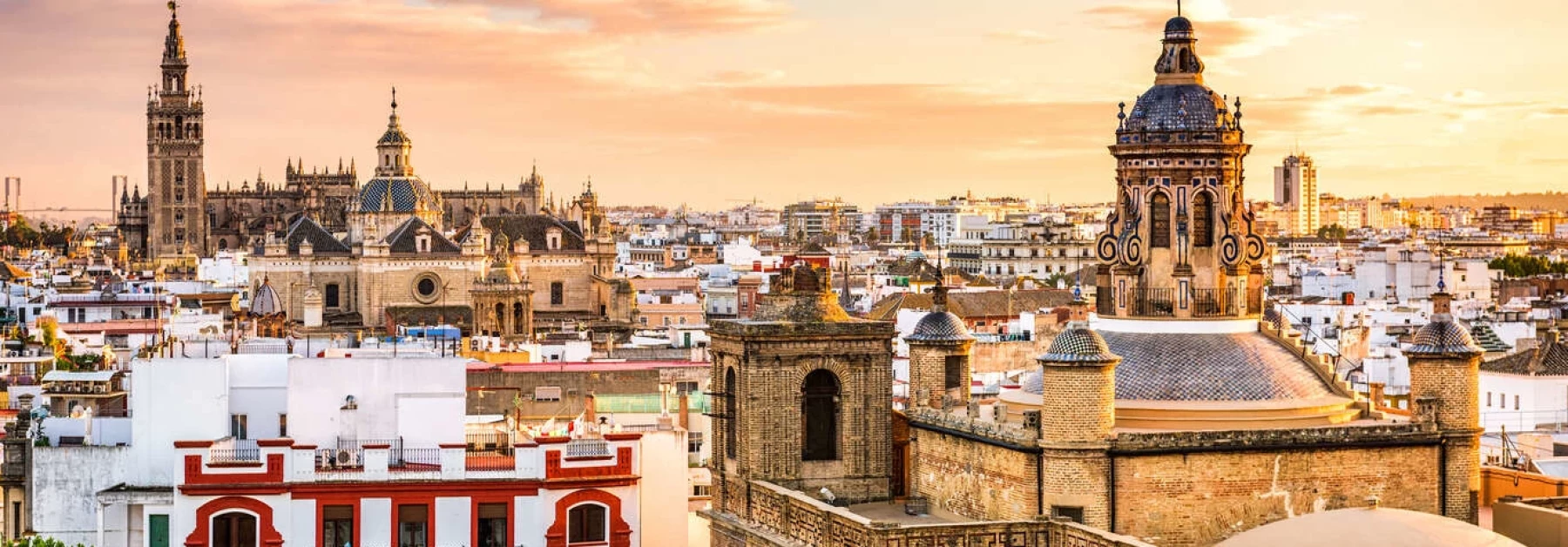To visit - Andalusia
Andalusia is a region located in southern Spain, known for its rich history, vibrant culture, Moorish architecture, and stunning beaches. It has been deeply influenced by various civilizations that have ruled the Iberian Peninsula, including the Romans, Moors, and Christians.
Among Andalusia's most famous attractions are the Alhambra in Granada, a Moorish palace adorned with lush gardens and fountains, as well as the Great Mosque of Cordoba, an iconic site of Islamic architecture. Seville, the capital of the region, is renowned for its massive cathedral, royal palace (the Alcázar), and picturesque Santa Cruz neighborhood.
In addition to its rich cultural heritage, Andalusia is also famous for its lively traditional festivals, such as the Feria de Abril in Seville and the Feria de Agosto in Malaga. The region is also known for its gastronomy, which includes dishes like gazpacho, paella, and tapas, as well as renowned local wines such as Jerez sherry.
In addition to its cultural heritage, Andalusia offers a variety of landscapes, ranging from the mountains of the Sierra Nevada to the sunny beaches of the Costa del Sol, to the vast plains of the interior. This diversity makes it a popular destination for travelers seeking adventure, relaxation, or cultural discovery.
The 18 essential things to do in Andalusia :
Summary
- To visit
-
- 1 - Seville
- 2 - Grenade
- 3 - Cordoba
- 4 - Málaga
- 5 - Ronda
- 6 - Marbella
- 7 - Doñana National Park
- 8 - Sierra Nevada
- 9 - Jerez de la Frontera
- 10 - Cadix
- 11 - Nerja
- 12 - Antequera
- 13 - Arcos de la Frontera
- 14 - Setenil de las bodegas
- 15 - Baeza and Úbeda
- 16 - Cabo de Gata-Níjar
- 17 - Itálica
- 18 - Costa del Sol
- Andalusia - Where to Stay?
- Andalusia - How to get around?
- Andalusia - Best period
1 - Seville
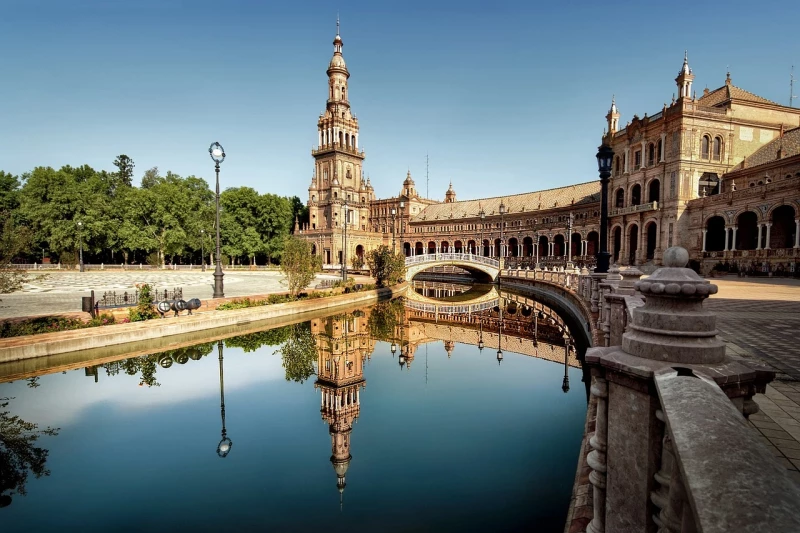
A trip to Seville is an unforgettable experience! Located in southern Spain, Seville is a city steeped in history, culture, and charm. Here are some highlights to consider for your trip:
-
Seville Cathedral and the Giralda: Seville Cathedral is one of the largest in the world and boasts impressive architecture. Be sure to climb to the top of the Giralda, its bell tower, for panoramic views of the city.
-
Alcazar of Seville: This royal palace is a masterpiece of Moorish architecture. Its lush gardens, tiled patios, and richly decorated halls make it a must-visit.
-
Santa Cruz Quarter: Wander through the narrow streets of this picturesque neighborhood, filled with whitewashed houses, flower-filled courtyards, and charming squares. It's the perfect place to enjoy tapas or sip a glass of Spanish wine.
-
Triana Quarter: Across the Guadalquivir River lies this lively neighborhood, known for its traditional pottery, nightlife, and flamenco bars.
-
Real Maestranza Bullring and La Macarena Quarter: Explore this authentic district, where you can visit Spain's oldest bullfighting arena and discover the La Macarena basilica.
-
Flamenco: Attend a flamenco show, a captivating Andalusian tradition that blends passionate dance, music, and singing.
-
Local cuisine: Don't miss the delights of Sevillian gastronomy, from tapas to traditional dishes like paella or salmorejo, a delicious cold tomato soup.
Be sure to enjoy Seville's sunny climate, especially in spring and autumn when temperatures are milder. With its unique blend of historical heritage, lively atmosphere, and Spanish charm, Seville is sure to enchant you!
Learn more  Our tips for getting the most out of your experience.
Our tips for getting the most out of your experience.
Here are some tips for visiting Seville:
-
Comfortable Footwear: Seville is a city best explored on foot, with many narrow streets and historic sites close together. Make sure to wear comfortable walking shoes to navigate the cobblestone streets and enjoy your explorations without discomfort.
-
Sun Protection: Seville can get quite hot, especially in the summer months. Don't forget to bring sunscreen, a hat, and sunglasses to protect yourself from the sun while exploring the city.
-
Siesta Schedule: Keep in mind that many shops and businesses in Seville close for a few hours in the afternoon for siesta. Plan your activities accordingly, and take advantage of this time to enjoy a leisurely lunch or a siesta yourself.
-
Visit Popular Sites Early: To avoid crowds and long lines, try to visit popular attractions like the Alcazar and the Cathedral early in the morning or later in the afternoon. This will allow you to enjoy these sites with more space and less waiting time.
-
Tapas Culture: Embrace the local tapas culture by hopping from one tapas bar to another. Instead of sitting down for a full meal, sample a variety of small dishes at different bars to get a taste of Seville's culinary delights.
-
Learn Some Basic Spanish Phrases: While many people in Seville speak English, knowing some basic Spanish phrases can go a long way in enhancing your experience and connecting with locals.
-
Explore Beyond the Tourist Areas: While the main attractions in Seville are certainly worth visiting, don't be afraid to wander off the beaten path and explore the city's lesser-known neighborhoods. You never know what hidden gems you might discover!
-
Public Transportation: Seville has an efficient public transportation system, including buses and trams, which can be a convenient way to get around the city. Consider purchasing a rechargeable transport card for ease of use.
-
Respect Local Customs: Remember to dress modestly when visiting religious sites like churches and cathedrals, and be mindful of local customs and etiquette to show respect for the culture and traditions of Seville.
By keeping these tips in mind, you'll be well-prepared to make the most of your visit to Seville and create lasting memories in this beautiful city!
2 - Grenade
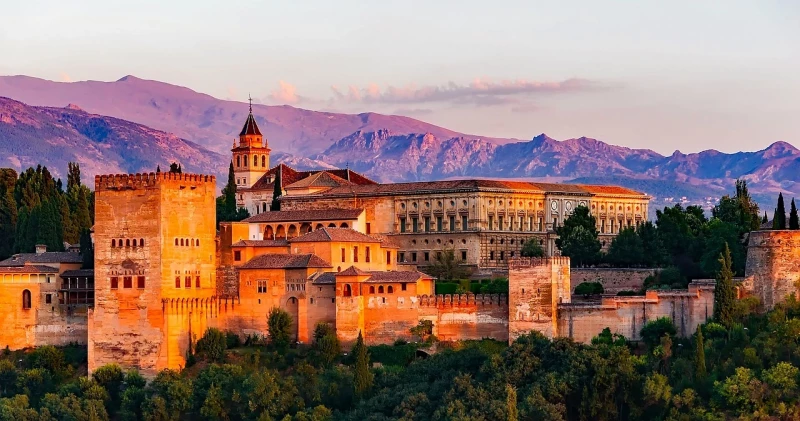
A trip to Granada, Spain, offers a rich experience in history, culture, and natural beauty. Here are some of the attractions and activities you might consider during your stay:
-
The Alhambra: This magnificent Moorish palace is one of Granada's main attractions. Explore the Nasrid Palaces, the lush gardens of the Generalife, and the impressive fortifications of this fortress dating back to the 9th century.
-
The Albaicín Quarter: This picturesque Moorish neighborhood is a maze of winding streets, whitewashed houses, and stunning views of the Alhambra. Stroll through its narrow streets and discover charming cafes, craft shops, and panoramic viewpoints.
-
Granada Cathedral: This imposing cathedral, built in the 16th century, is a beautiful example of Spanish Gothic architecture. Don't miss the Royal Chapel where the Catholic Monarchs, Ferdinand II of Aragon and Isabella I of Castile, are buried.
-
The Arab Baths: Enjoy a relaxing experience in Granada's Arab baths, where you can unwind in hot baths, saunas, and relaxation rooms while soaking up the historical atmosphere of these places.
-
Local cuisine: Sample the delights of Andalusian cuisine, including traditional tapas, refreshing gazpacho, and dishes made with fresh seafood. Be sure to visit local tapas bars for an authentic culinary experience.
-
Flamenco shows: Attend an exciting flamenco show at one of Granada's many tablaos, where you can admire the flamboyant dance, haunting music, and emotional expression of this traditional Spanish art form.
-
Nature walks: Explore the surroundings of Granada by hiking in the Sierra Nevada mountains or strolling along the picturesque banks of the Rio Darro.
Granada is a fascinating destination that combines history, culture, and natural beauty, offering visitors an unforgettable experience.
 Our tips for getting the most out of your experience.
Our tips for getting the most out of your experience.
Here are some tips for visiting Granada:
-
Book Alhambra tickets in advance: The Alhambra is Granada's most popular attraction, and tickets often sell out quickly. Be sure to book your tickets online in advance to secure your entry, especially during peak tourist seasons.
-
Explore the Albaicín early in the day: The Albaicín neighborhood is best explored in the morning when it's less crowded. Wander through its narrow streets, enjoy the views, and discover its hidden gems before the crowds arrive.
-
Wear comfortable shoes: Granada's streets can be steep and uneven, especially in the Albaicín and Albayzín neighborhoods. Wear comfortable shoes suitable for walking on cobblestones and inclines.
-
Stay hydrated: Granada can get quite hot, especially in the summer months. Be sure to carry a water bottle with you and stay hydrated throughout the day, especially when exploring outdoor attractions like the Alhambra or hiking in the Sierra Nevada.
-
Try the local cuisine: Granada is famous for its tapas culture, where you often get a free tapa with your drink order. Take advantage of this and try different tapas at various bars and restaurants to experience the local cuisine.
-
Visit off-peak hours: To avoid crowds at popular attractions like the Alhambra and the Cathedral, consider visiting early in the morning or later in the afternoon. You'll have a more enjoyable experience with fewer people around.
-
Use public transportation: Granada has an efficient public transportation system, including buses and taxis. Consider using public transportation to get around the city, especially if you're staying outside the city center.
-
Respect cultural norms: Granada is a city with a rich cultural heritage, so be respectful of local customs and traditions. Dress modestly when visiting religious sites, and be mindful of noise levels, especially in residential areas.
-
Learn some basic Spanish: While many people in Granada speak English, knowing some basic Spanish phrases can enhance your experience and help you communicate with locals.
-
Take your time: Granada is a city best explored at a leisurely pace. Take your time to soak in the sights, sounds, and flavors of this beautiful city without feeling rushed.
3 - Cordoba
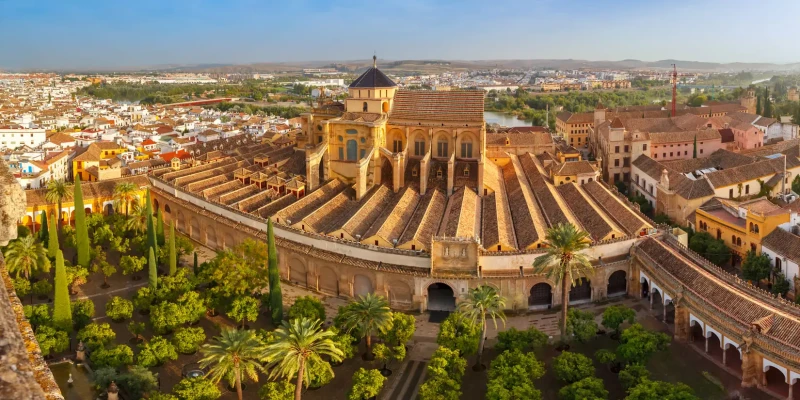
Cordoba, a city nestled in the heart of Andalusia, Spain, beckons travelers with its rich history, cultural heritage, and architectural marvels. Steeped in centuries of Islamic, Christian, and Jewish influences, Cordoba offers a captivating blend of Moorish palaces, Roman remnants, and medieval charm.
At the heart of the city stands the majestic Mosque-Cathedral of Cordoba, a testament to the city's diverse past. Its stunning architecture, with its intricate arches, columns, and mihrab, reflects the centuries of Islamic rule. Walking through its prayer halls, one can feel the echoes of history whispering through the ages.
Beyond the Mosque-Cathedral, Cordoba's old town, a UNESCO World Heritage Site, invites exploration with its labyrinthine streets, adorned with vibrant flower-filled patios and hidden plazas. The iconic Calleja de las Flores, with its cascading blossoms against whitewashed walls, is a photographer's delight and a symbol of Cordoba's enchanting beauty.
For history enthusiasts, the Alcazar de los Reyes Cristianos offers a glimpse into Cordoba's medieval past. Once a fortress-palace of the Christian kings, it boasts splendid gardens, tranquil ponds, and panoramic views of the city.
As the sun sets, Cordoba comes alive with the rhythmic beats of flamenco music and the aroma of delectable Andalusian cuisine. Sample local specialties like salmorejo, a refreshing cold tomato soup, or venture into a traditional tavern for a taste of Cordoba's famous tapas.
With its captivating blend of history, architecture, and gastronomy, a voyage to Cordoba promises an unforgettable journey through the soul of Andalusia.
Learn more  Our tips for getting the most out of your experience.
Our tips for getting the most out of your experience.
Here are some tips for visiting Cordoba:
-
Book Tickets in Advance: If you plan to visit popular attractions like the Mosque-Cathedral (Mezquita) or the Alcazar de los Reyes Cristianos, consider booking your tickets in advance online. This can help you skip the long lines, especially during peak tourist seasons.
-
Visit Early or Late: To avoid crowds, try to visit major attractions early in the morning or later in the afternoon. This way, you can enjoy the sights with fewer people around and capture better photos without the crowds.
-
Wear Comfortable Shoes: Cordoba's historic center is best explored on foot, with its narrow streets and cobblestone alleys. Make sure to wear comfortable shoes as you'll likely be doing a lot of walking.
-
Respect Dress Code: When visiting religious sites like the Mosque-Cathedral, be mindful of the dress code. Both men and women should ensure their shoulders and knees are covered as a sign of respect.
-
Explore Beyond the Main Attractions: While the Mosque-Cathedral and Alcazar are must-see sights, don't forget to explore Cordoba's charming neighborhoods, such as the Jewish Quarter (Judería), with its narrow streets and picturesque patios.
-
Try Local Cuisine: Cordoba is known for its delicious food, so be sure to try local specialties like salmorejo (cold tomato soup), flamenquín (breaded pork or ham roll), and berenjenas con miel (fried eggplant with honey). Visit traditional taverns or tapas bars to experience authentic Andalusian cuisine.
-
Take a Guided Tour: Consider joining a guided tour to learn more about Cordoba's history and culture from knowledgeable local guides. There are walking tours, bike tours, and even food tours available, catering to various interests.
-
Stay Hydrated: Cordoba can get quite hot, especially in the summer months. Be sure to carry water with you and stay hydrated as you explore the city.
-
Learn Some Spanish Phrases: While many people in Cordoba speak English, knowing some basic Spanish phrases can enhance your experience and help you interact with locals.
-
Be Prepared for Siesta: Keep in mind that many shops and businesses in Cordoba observe the traditional siesta break in the early afternoon, typically from around 2 pm to 5 pm. Plan your activities accordingly and take this time to rest or enjoy a leisurely meal.
4 - Málaga
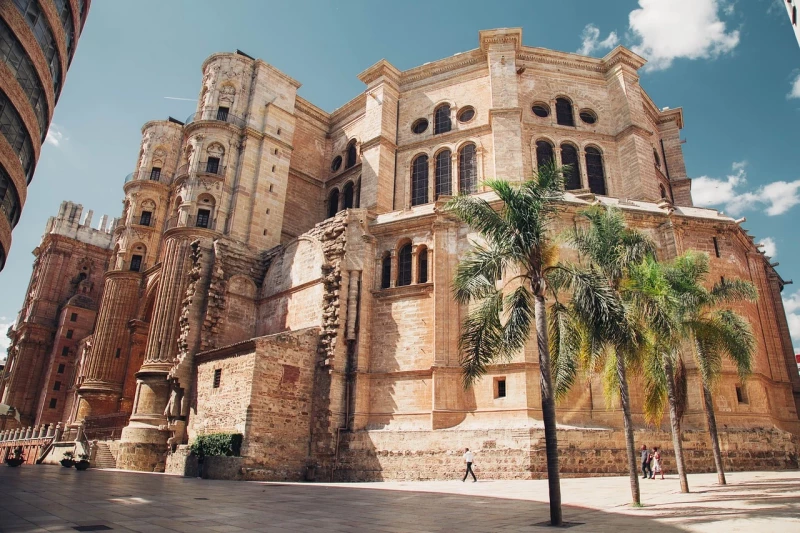
A trip to Malaga, Spain, promises an experience rich in culture, history, and sunny pleasures. Here are some suggestions to make the most of your journey:
-
Visit the Alcazaba and Gibralfaro Castle: These two historical monuments offer panoramic views of the city and the Mediterranean Sea. The Alcazaba is a well-preserved Moorish fortress, while Gibralfaro Castle boasts impressive architecture and tranquil gardens.
-
Relax on the beaches: Malaga boasts a beautiful coastline with golden sandy beaches. Among the most popular are La Malagueta Beach, easily accessible from the city center.
-
Explore the historic center: Lose yourself in the narrow streets of the old town where you'll find historic churches, lively squares, quaint shops, and excellent tapas bars.
-
Visit the Picasso Museum: Malaga is the birthplace of Pablo Picasso, and its museum houses an extensive collection of the famous artist's works, offering a fascinating insight into his artistic evolution.
-
Indulge in local cuisine: Don't miss out on tasting Malaga's culinary specialties, such as pescaíto frito (fried fish), espetos de sardines grilled on the beach, and, of course, delicious local wines and desserts like Malaga raisins.
-
Take a day trip to Nerja or Ronda: If you have time, consider taking a day trip to Nerja to visit its impressive caves or to Ronda to explore its spectacular landscapes and famous bridge.
-
Attend a flamenco show: Immerse yourself in Spanish culture by attending a flamenco show, a captivating experience that captures the very essence of Andalusia.
Don't forget to soak up the relaxed and sunny atmosphere of Malaga by strolling its streets, sipping sangria on a terrace, and simply letting yourself be carried away by the charm of this dynamic city.
 Our tips for getting the most out of your experience.
Our tips for getting the most out of your experience.
Here are some tips for visiting Malaga:
-
Plan according to the weather: Malaga generally enjoys pleasant weather throughout the year, but it can get very hot in summer. Make sure to wear light clothing and apply sunscreen, especially if you plan to spend time outdoors.
-
Use public transportation: Malaga has a good network of buses and trains, making it easy to get around the city and its surroundings. You can also consider renting a bike to explore the city at your own pace.
-
Purchase the Malaga Tourist Card: This card grants you access to many of the city's tourist attractions, as well as discounts at select shops and restaurants. It's a great way to save money while exploring Malaga.
-
Avoid peak hours for visiting tourist attractions: To dodge the crowds, try to visit tourist sites early in the morning or late in the afternoon. This will allow you to fully enjoy your visit without feeling overwhelmed by the crowd.
-
Taste local cuisine at tapas bars: Tapas bars are an institution in Spain, and Malaga is no exception. Don't miss the chance to sample local specialties at these friendly and lively establishments.
-
Learn a few basic Spanish phrases: While many people in Malaga speak English, learning some basic Spanish words can enhance your stay and help you connect with locals.
-
Explore off-the-beaten-path neighborhoods: While Malaga's historic center is beautiful, don't hesitate to explore less touristy neighborhoods to discover a more authentic side of the city and its culture.
By following these tips, you'll be ready to make the most of your visit to Malaga and uncover all that this fascinating city has to offer.
5 - Ronda
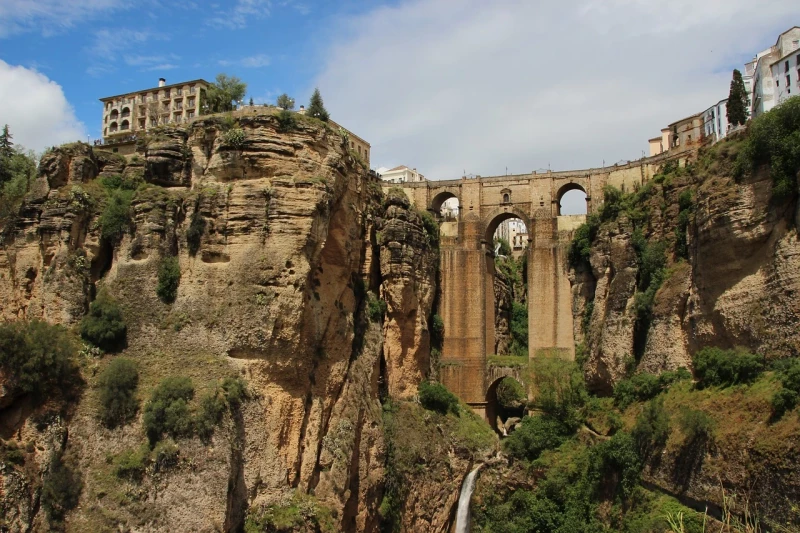
Ronda is a picturesque town located in the province of Malaga, Spain. It is renowned for its spectacular landscapes, historic landmarks, and its iconic bridge spanning the famous Tajo gorge. If you're considering a trip to Ronda, here are some points to consider:
-
Puente Nuevo (New Bridge): This is Ronda's most iconic attraction, offering breathtaking views of the deep gorge that divides the town into two parts.
-
Alameda del Tajo: A beautiful park located near the Puente Nuevo, offering panoramic views of the surrounding area.
-
Old Town: Stroll through the narrow, winding streets of Ronda's old town to discover its historic charm, ancient churches, and whitewashed houses.
-
Plaza de Toros (Bullring): Ronda is home to one of Spain's oldest bullrings, where you can learn about the history of bullfighting.
-
Arab Baths (Baños Árabes): These well-preserved Moorish baths offer insight into the Arab architecture and culture that influenced the region.
-
Ronda Museum (Museo de Ronda): Explore local history and art in this museum located in the Mondragón Palace, a former Moorish residence.
-
Gastronomy: Enjoy delicious Andalusian cuisine, including gazpacho, tapas, and local wines.
-
Hiking and Nature: The surroundings of Ronda offer numerous hiking opportunities through beautiful landscapes, including the Sierra de Grazalema Natural Park.
Make sure to soak up the town's tranquil atmosphere, stunning views, and relaxed vibe. Ronda is a perfect place to get lost in the history and natural beauty of Andalusia.
 Our tips for getting the most out of your experience.
Our tips for getting the most out of your experience.
If you're planning to visit Ronda, here are some tips to make the most of your trip:
-
Plan your visit: Ronda may be a small town, but there's plenty to see. Plan ahead which sites you want to visit to optimize your time there.
-
Avoid the crowds: Major attractions in Ronda, such as the New Bridge and the bullring, can get very crowded, especially during peak tourist season. Try to visit them early in the morning or late in the afternoon to avoid the crowds.
-
Wear comfortable shoes: Ronda's topography is hilly, with cobbled streets and stairs. Make sure to wear comfortable shoes to explore the town without discomfort.
-
Explore on foot: Ronda is a great town for walking. Get lost in the narrow alleys of the old town and discover its hidden charms.
-
Respect local traditions: Ronda has a rich bullfighting tradition. If you attend a bullfight or visit the bullring, respect local customs, even if they may be controversial.
-
Taste the local cuisine: Don't miss out on trying delicious Andalusian cuisine during your stay in Ronda. Sample tapas, gazpacho, salmorejo, and local wines.
-
Explore the surroundings: The surrounding areas of Ronda offer beautiful nature and picturesque villages. Take the time to explore the surrounding countryside and typical white villages of Andalusia.
-
Use public transportation: If you don't have your own means of transportation, Ronda is well-connected by buses and trains. You can also opt for guided tours to explore the region with ease.
By following these tips, you'll be able to fully enjoy your visit to Ronda and discover everything this charming town has to offer.
6 - Marbella
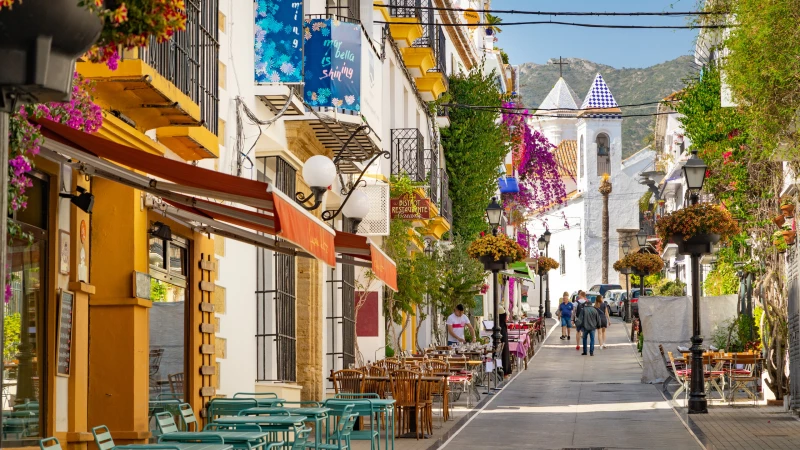
Marbella is a popular holiday destination on the Costa del Sol in Spain, known for its sunny climate, beautiful beaches, lively nightlife, and luxury resorts. Here are some tips for planning your trip to Marbella:
-
Choose the right time to go: Marbella enjoys a warm Mediterranean climate, making it a pleasant destination year-round. However, the summer months (June to August) are the most popular but also the busiest. If you prefer milder temperatures and fewer tourists, consider traveling in the spring (April-May) or fall (September-October).
-
Explore the beaches: Marbella boasts gorgeous sandy beaches lined with beach bars and restaurants. Popular beaches include Playa de la Fontanilla, Playa de la Bajadilla, and Playa de Nagueles.
-
Discover the Old Town (Casco Antiguo): Get lost in the picturesque streets of Marbella's Old Town, where you can admire traditional architecture, shady squares, and local shops.
-
Visit the marina (Puerto Banús): Puerto Banús is renowned for its glamour and lively nightlife. Here, you'll find luxurious yachts, designer boutiques, chic restaurants, and trendy bars.
-
Enjoy water sports: Marbella offers a wealth of water activities, such as sailing, jet skiing, windsurfing, and paddleboarding. Water sports enthusiasts will find plenty to do on the region's beaches.
-
Explore the hinterland: Venture away from the coast to explore Marbella's picturesque hinterland, with its traditional white villages, mountain landscapes, and hiking trails.
-
Indulge in local cuisine: Don't miss the chance to sample delicious Andalusian cuisine at Marbella's many restaurants. Try local specialties such as gazpacho, paella, and pescaíto frito (fried fish).
-
Book in advance: Marbella is a popular tourist destination, so it's recommended to book your accommodation and activities in advance, especially during the high season.
By following these tips, you'll be able to make the most of your trip to Marbella and experience all that this sunny destination has to offer.
 Our tips for getting the most out of your experience.
Our tips for getting the most out of your experience.
Si vous prévoyez de visiter Marbella, voici quelques astuces pour améliorer votre expérience :
-
Explorer la vieille ville : Le vieux quartier de Marbella, connu sous le nom de Casco Antiguo, est un endroit charmant avec des rues pavées étroites, des bâtiments historiques et des places pittoresques. Prenez votre temps pour vous promener dans ses ruelles pittoresques, découvrir des trésors cachés et vous arrêter pour des tapas dans les restaurants locaux.
-
Profiter des plages : Marbella dispose de plusieurs belles plages le long de sa côte. Que vous recherchiez une atmosphère animée avec des clubs de plage et des sports nautiques ou une étendue de sable plus calme pour vous détendre, il y a une plage pour tout le monde. Quelques options populaires incluent Playa de la Fontanilla, Playa de la Venus et la plage de Puerto Banús.
-
Visiter Puerto Banús : Cette marina haut de gamme est un incontournable à Marbella, offrant des boutiques de luxe, des restaurants et des options de divertissement. Promenez-vous le long de la promenade en bord de mer, admirez les yachts et faites un peu de shopping dans les boutiques de créateurs.
-
Explorer les activités de plein air : Les environs naturels de Marbella offrent de nombreuses possibilités d'aventures en plein air. Envisagez de faire de la randonnée dans les montagnes de la Sierra Blanca, de jouer au golf sur l'un des nombreux parcours prestigieux ou de partir en excursion en bateau le long de la côte.
-
Goûter à la cuisine locale : Marbella abrite une scène culinaire diversifiée, avec des restaurants proposant des plats traditionnels andalous ainsi que des cuisines internationales. Assurez-vous de goûter aux spécialités locales comme le gazpacho, la paella et les fruits de mer frais.
-
Planifier des excursions d'une journée : La situation de Marbella en fait une excellente base pour explorer d'autres destinations à proximité. Envisagez des excursions d'une journée dans des villages blancs charmants comme Mijas ou Ronda, des visites d'attractions culturelles telles que l'Alhambra de Grenade ou l'exploration de la ville cosmopolite de Malaga.
-
Se protéger du soleil : Marbella bénéficie d'un climat méditerranéen avec beaucoup de soleil, alors assurez-vous de rester hydraté et de vous protéger des rayons du soleil. Portez de la crème solaire, un chapeau et des lunettes de soleil, et cherchez de l'ombre pendant les heures les plus chaudes de la journée.
-
Respecter les coutumes locales : Marbella est une destination touristique populaire, mais il est important de respecter les coutumes et les traditions locales. Habillez-vous modestement lors de la visite de sites religieux, respectez les règles de conduite sur la plage et soyez attentif au niveau de bruit, surtout tard dans la nuit.
En gardant ces conseils à l'esprit, vous pouvez profiter au maximum de votre visite à Marbella et créer des souvenirs inoubliables dans cette ville côtière dynamique.
7 - Doñana National Park
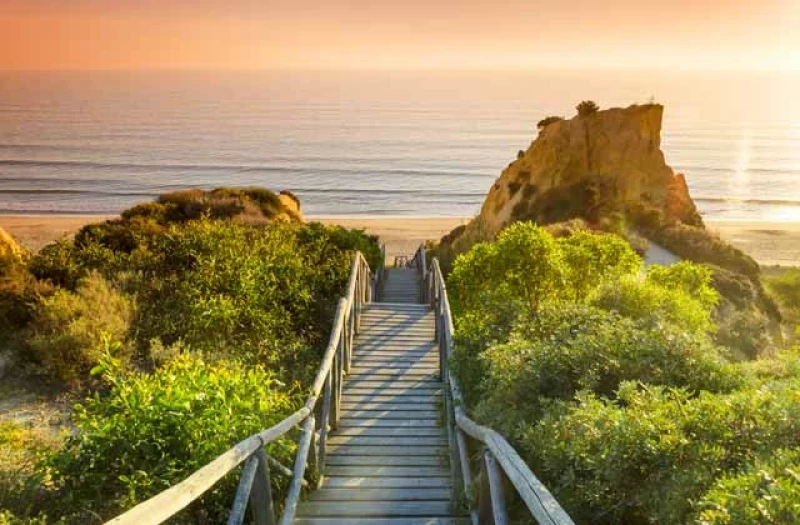
The Doñana National Park is a renowned natural reserve located in southwestern Spain, primarily in the provinces of Huelva, Seville, and Cádiz. Here are some key points about the park:
-
Ecological Importance: Doñana National Park is one of Europe's most important wetland reserves and is recognized as a UNESCO World Heritage Site. It serves as a crucial habitat for numerous bird species, including migratory birds traveling between Europe and Africa.
-
Biodiversity: The park is characterized by a diverse range of ecosystems, including marshlands, sand dunes, Mediterranean forests, and freshwater lagoons. Its varied habitats support a rich array of flora and fauna, including endangered species such as the Iberian lynx and the Spanish imperial eagle.
-
Birdwatching: Doñana is a paradise for birdwatchers, attracting enthusiasts from around the world. It provides habitat for over 300 bird species, including flamingos, herons, egrets, and ospreys. The park's extensive network of trails and observation points offers excellent opportunities for birdwatching.
-
Wildlife: In addition to its birdlife, Doñana National Park is home to a diverse range of wildlife, including mammals like deer, wild boar, and mongoose, as well as reptiles, amphibians, and insects.
-
Conservation Efforts: Due to its ecological significance and the threats it faces from human activities such as agriculture, urbanization, and tourism, Doñana National Park is subject to strict conservation measures. Conservation efforts aim to preserve the park's biodiversity while promoting sustainable land use practices.
-
Visiting the Park: The park is open to visitors, but access to certain areas may be restricted to protect sensitive habitats and wildlife. Visitors can explore the park on foot, by bicycle, or on guided tours led by knowledgeable local guides. There are also visitor centers where visitors can learn more about the park's ecosystems and conservation efforts.
Overall, Doñana National Park is a unique and invaluable natural treasure, offering visitors the chance to experience the beauty and diversity of one of Europe's most important wetland ecosystems.
 Our tips for getting the most out of your experience.
Our tips for getting the most out of your experience.
If you're planning to visit Doñana National Park, here are some tips to make the most of your experience:
-
Plan in Advance: Doñana is a protected area with limited access, especially during peak seasons. Plan your visit in advance and consider making reservations for guided tours or accommodations well ahead of time.
-
Choose the Right Time: The best time to visit Doñana depends on your interests. Birdwatchers may prefer the spring and autumn migration seasons when bird activity is at its peak. However, other times of the year can also offer unique experiences, such as the breeding season for certain species.
-
Join a Guided Tour: While parts of Doñana can be explored independently, joining a guided tour led by knowledgeable local guides can greatly enhance your experience. Guides can help you spot wildlife, provide insights into the park's ecology and history, and ensure you visit the most interesting areas while minimizing your impact on the environment.
-
Respect Wildlife and Regulations: Doñana is a protected area, and it's essential to respect wildlife and follow park regulations. Stay on designated trails, avoid disturbing animals, and refrain from littering or leaving any trace of your visit.
-
Bring Binoculars and Camera: Doñana is famous for its birdlife and wildlife, so be sure to bring binoculars and a camera with a telephoto lens to capture memorable moments. However, remember to respect wildlife and maintain a safe distance.
-
Dress Appropriately: Weather conditions in Doñana can vary, so dress in layers and wear sturdy walking shoes suitable for hiking. Don't forget to bring sun protection, such as a hat, sunscreen, and plenty of water.
-
Stay Informed: Before your visit, check for any updates or restrictions on park access, especially if you plan to visit during peak seasons. Visitor centers and park staff can provide valuable information about current conditions, recommended trails, and wildlife sightings.
-
Enjoy the Experience: Finally, take the time to immerse yourself in the beauty of Doñana National Park. Listen to the sounds of nature, observe the diverse flora and fauna, and appreciate the tranquility of this unique natural environment.
By following these tips, you can have a rewarding and memorable experience exploring the wonders of Doñana National Park while respecting its delicate ecosystem and wildlife.
8 - Sierra Nevada
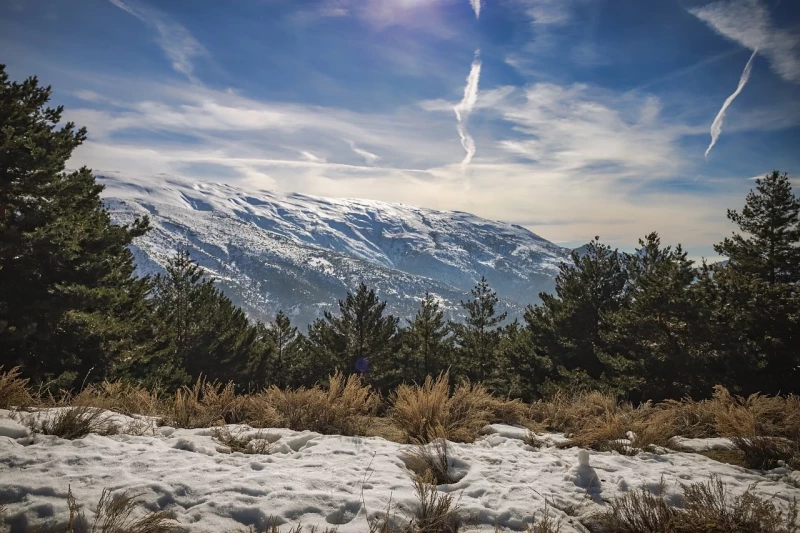
A trip to Sierra Nevada in Spain promises an unforgettable experience for nature lovers, adventure seekers, and those who appreciate spectacular landscapes. Sierra Nevada is a mountain range located in southern Spain, primarily in Andalusia, and it's famous for being home to the highest peak in the Iberian Peninsula, Mulhacén, which rises over 3,400 meters above sea level.
Here are some activities you might consider during a trip to Sierra Nevada:
-
Hiking: Explore hiking trails that wind through breathtaking mountain landscapes, offering stunning views of the valleys below and the surrounding peaks.
-
Skiing and snowboarding: In winter, Sierra Nevada is one of Spain's premier destinations for winter sports, offering slopes for all levels, as well as modern facilities.
-
Wildlife and flora observation: Sierra Nevada boasts remarkable biodiversity, with endemic species and a variety of ecosystems, including pine forests, alpine meadows, and glacial lakes.
-
Climbing: For climbing enthusiasts, Sierra Nevada offers a multitude of climbing routes, ranging from beginner to expert level, with impressive rock walls.
-
Relaxation: Enjoy picturesque villages nestled in the mountains, where you can indulge in delicious local cuisine, discover traditional crafts, and unwind in a peaceful setting.
Whether it's for an active mountain vacation or simply to recharge amidst nature, a trip to Sierra Nevada in Spain promises a rewarding and memorable experience.
9 - Jerez de la Frontera
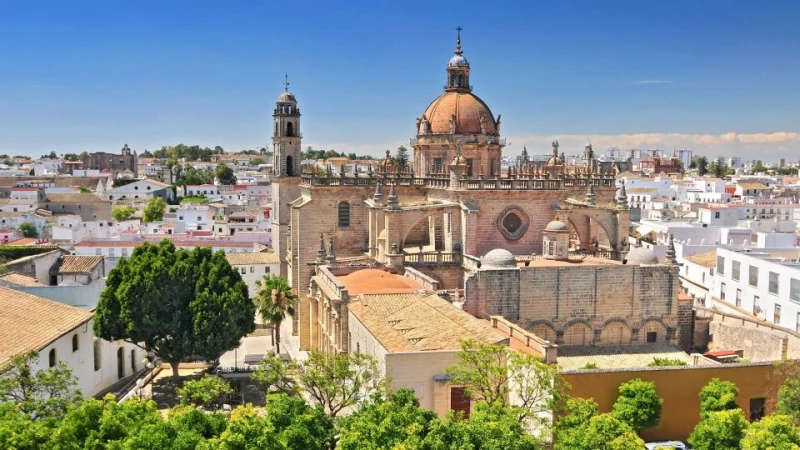
A trip to Jerez de la Frontera offers a delightful blend of culture, history, and gastronomy. Here are some tips for your visit:
-
Explore the Sherry Bodegas: Jerez is renowned for its sherry production. Take a tour of one of the traditional bodegas, such as Tio Pepe or Gonzalez Byass, to learn about the sherry-making process and enjoy tastings of this iconic Spanish wine.
-
Visit the Royal Andalusian School of Equestrian Art: Jerez is famous for its Andalusian horses. Witness a spectacular equestrian show at the Royal Andalusian School of Equestrian Art, where you can see these magnificent animals perform classical dressage routines.
-
Discover the Old Town: Wander through the charming streets of Jerez's historic center, where you'll find beautiful architecture, including the impressive Jerez Cathedral and the Alcazar of Jerez. Don't miss Plaza del Arenal, the main square, which is bustling with activity and lined with cafes and shops.
-
Experience Flamenco: Immerse yourself in the passion of flamenco, a traditional art form deeply rooted in Andalusian culture. Catch a live flamenco performance at one of the local tablaos or peñas to witness the captivating music and dance firsthand.
-
Indulge in Local Cuisine: Sample the delicious Andalusian cuisine in Jerez's many tapas bars and restaurants. Don't forget to try local specialties like salmorejo (a chilled tomato soup), pescaíto frito (fried fish), and of course, the region's famous cured meats and cheeses.
-
Take a Day Trip: Jerez makes an excellent base for exploring the surrounding area. Consider taking a day trip to nearby attractions such as Cadiz, with its stunning beaches and historic landmarks, or the white hilltop villages of Arcos de la Frontera and Vejer de la Frontera.
-
Enjoy the Festivals: Experience the vibrant local culture by attending one of Jerez's many festivals and events throughout the year. The Feria del Caballo (Horse Fair) in May is particularly famous, featuring equestrian shows, flamenco performances, and lively street parties.
By following these tips, you're sure to have a memorable and enriching experience in Jerez de la Frontera, soaking in the rich history, culture, and flavors of this captivating Andalusian city.
10 - Cadix
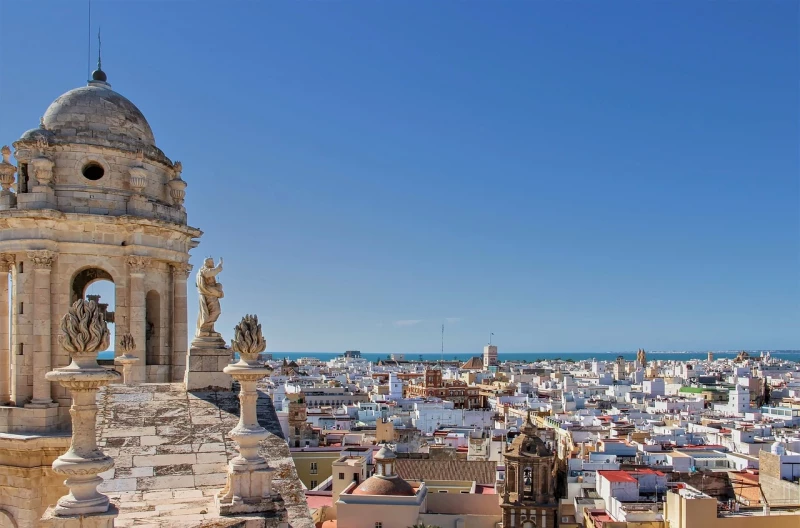
Cadiz, also known as Cadiz in Spanish, is a port city located in southwestern Spain, in Andalusia. Founded over 3,000 years ago by the Phoenicians, Cadiz is one of the oldest cities in Western Europe, boasting impressive historical and cultural wealth.
If you're considering a trip to Cadiz, here are some highlights you won't want to miss:
-
Old Quarter (Casco Antiguo): Stroll through the narrow, winding streets of the old town, discovering picturesque squares, ancient churches, and historic buildings.
-
Cadiz Cathedral: Known as the "Catedral Nueva" (new cathedral), this impressive structure is a remarkable example of Spanish Baroque architecture. Be sure to climb to the top for panoramic views of the city.
-
Roman Theatre of Cadiz: Dating back to the 1st century BC, this restored Roman theater is one of the oldest in Spain, offering fascinating insight into the region's Roman history.
-
Beaches: Cadiz is surrounded by beautiful sandy beaches. Among the most popular are La Caleta Beach, located in the heart of the city, and Victoria Beach, larger and more frequented.
-
Fortifications and Castles: Explore the remains of the city's ancient fortifications, including San Sebastián Castle and Santa Catalina Castle, which offer stunning views of the coast.
-
Gastronomy: Don't miss out on tasting local culinary delights, including fresh fish, seafood, the famous "tortillita de camarones" (a shrimp-based specialty), and "pescaíto frito" (fried fish).
-
Festivals and Events: If possible, plan your trip to coincide with one of Cadiz's many festivals and cultural events, such as the famous Cadiz Carnival, one of the largest and most colorful in Spain.
Whether you're interested in history, culture, cuisine, or simply lounging on the beach, Cadiz offers an unforgettable experience for travelers.
 Our tips for getting the most out of your experience.
Our tips for getting the most out of your experience.
If you're planning to visit Cadiz, here are some tips to make the most of your trip:
-
Comfortable Footwear: Cadiz's old town is full of narrow streets and cobblestone pathways, so wear comfortable walking shoes to explore the city comfortably.
-
Sun Protection: Cadiz enjoys a sunny climate, especially in the summer months. Make sure to bring sunscreen, a hat, and sunglasses to protect yourself from the sun while exploring the city and its beaches.
-
Local Cuisine: Take the opportunity to indulge in Cadiz's delicious seafood dishes, such as fried fish and fresh seafood paella. Visit local tapas bars to sample a variety of traditional Andalusian cuisine.
-
Language: While many locals in Cadiz speak some English, it's always helpful to learn a few basic Spanish phrases. This can enhance your experience and make interactions with locals more enjoyable.
-
Explore Beyond the Old Town: While the old town is charming and full of history, don't miss out on exploring other areas of Cadiz, such as the modern city center and the picturesque beaches along the coast.
-
Visit Off-Peak Hours: To avoid crowds at popular tourist attractions, consider visiting early in the morning or later in the afternoon. This will allow you to enjoy the sights without feeling rushed or crowded.
-
Stay Hydrated: Especially during the hot summer months, it's important to stay hydrated while exploring Cadiz. Carry a water bottle with you and take breaks in the shade when needed.
-
Local Festivals: Check the local events calendar to see if any festivals or cultural events are taking place during your visit. Attending festivals like the Cadiz Carnival can provide a unique and memorable experience.
-
Public Transportation: Cadiz has an efficient public transportation system, including buses and ferries, which can help you navigate the city and its surrounding areas easily.
-
Respect Local Customs: Remember to respect local customs and traditions while visiting Cadiz. This includes dressing modestly when visiting religious sites and being courteous to locals.
By keeping these tips in mind, you can ensure a memorable and enjoyable visit to the beautiful city of Cadiz.
11 - Nerja
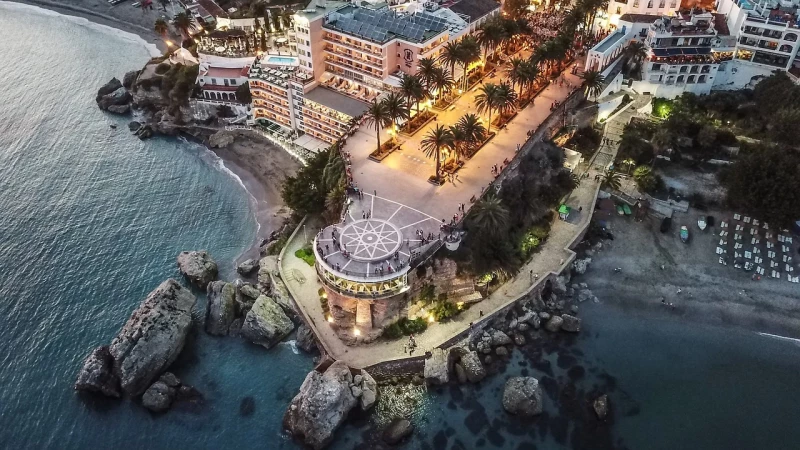
Nerja is a beautiful coastal town located in the province of Málaga in the Andalusia region of Spain. It's renowned for its stunning beaches, crystal-clear waters, and the famous Balcony of Europe, which offers breathtaking views of the Mediterranean Sea.
Here are some highlights and activities you might consider during your voyage to Nerja:
-
Balcony of Europe (Balcón de Europa): This is a must-visit spot in Nerja. It's a promenade with spectacular views overlooking the sea and the coastline. You can stroll along the promenade, enjoy the sea breeze, and take in the picturesque scenery.
-
Nerja Caves (Cuevas de Nerja): These caves are a fascinating natural attraction located just outside the town center. The caves are home to impressive stalactites and stalagmites, as well as archaeological discoveries dating back thousands of years. Guided tours are available for visitors.
-
Beaches: Nerja boasts several beautiful beaches with golden sands and clear waters. Some of the popular beaches include Burriana Beach, Playa de la Caletilla, and Playa de la Torrecilla. You can relax on the beach, soak up the sun, or engage in water activities such as swimming, snorkeling, and paddleboarding.
-
Hiking: The surrounding area of Nerja offers excellent hiking opportunities, especially in the nearby Sierra de Almijara mountains. You can explore scenic trails with panoramic views of the coastline and the mountains. One popular hiking route is the Rio Chillar trail, which takes you along a riverbed with waterfalls and natural pools.
-
Tapas and Cuisine: Indulge in the delicious Andalusian cuisine in Nerja. Explore the town's tapas bars and restaurants, where you can savor local specialties such as fresh seafood, gazpacho, paella, and fried fish. Don't forget to accompany your meals with a glass of Spanish wine or sangria.
-
Explore the Old Town: Take a leisurely stroll through Nerja's charming old town, with its narrow streets, white-washed buildings, and lively squares. You'll find quaint shops, boutiques, cafes, and bars tucked away in the winding streets.
-
Festivals and Events: Depending on the time of your visit, you might have the chance to experience one of Nerja's vibrant festivals or cultural events. These can include traditional flamenco performances, music festivals, and religious celebrations.
Whether you're seeking relaxation on the beach, adventure in nature, or immersion in Spanish culture and cuisine, Nerja offers a wonderful destination for your voyage.
12 - Antequera
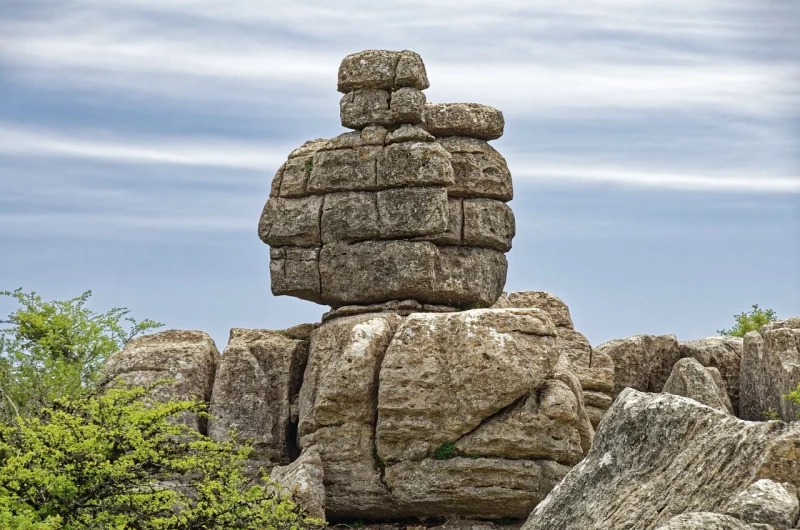
there are several points of interest you might want to explore:
-
Dolmens of Antequera: These megalithic structures are among the most impressive in Europe and are UNESCO World Heritage Sites. The dolmens of Antequera include Menga, Viera, and El Romeral.
-
Alcazaba of Antequera: This Moorish fortress offers panoramic views of the city and its surroundings. You can stroll along its ramparts and discover its fascinating history.
-
Real Colegiata de Santa María la Mayor: This impressive church combines Gothic, Renaissance, and Baroque styles. Don't miss visiting its stunning sacristy and museum of sacred art.
-
Torcal de Antequera: This natural park is famous for its unique karstic rock formations. You can hike through this spectacular landscape and observe its diverse flora and fauna.
-
Municipal Museum of Antequera: This museum houses a varied collection of archaeological artifacts, fine arts, and historical objects that trace the region's history from prehistory to the present day.
-
Church of San Sebastián: This 16th-century church is a remarkable example of Renaissance architecture in Antequera. It houses precious religious artworks and provides a fine example of local craftsmanship.
-
Plaza de Toros de Antequera: If you're interested in bullfighting, this historic bullring is worth a visit. Even if you don't attend a bullfight, you can tour the arena and learn more about this important aspect of Spanish culture.
These suggestions should help you start planning your trip to Antequera. Don't forget to enjoy the local cuisine, which includes delicious specialties like porra antequerana (a type of gazpacho) and molletes (small bread rolls). Have a great trip!
13 - Arcos de la Frontera
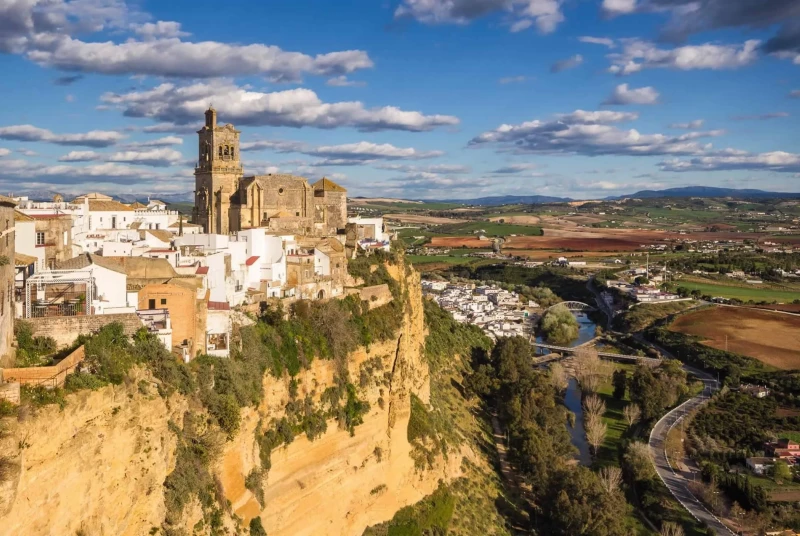
Arcos de la Frontera is a stunning town located in the province of Cádiz in Andalusia, Spain. Known for its breathtaking location atop a sandstone ridge overlooking the Guadalete River, Arcos is famous for its picturesque whitewashed houses, narrow winding streets, and rich cultural heritage. If you're planning a visit, here are some highlights to explore:
-
Historic Old Town: Wander through the charming streets of the historic center, where you'll find beautiful churches, squares, and traditional Andalusian architecture. Don't miss the Plaza del Cabildo and the Church of Santa María.
-
Church of Santa María: This impressive church is one of the main landmarks of Arcos. Its architectural style combines elements of Gothic, Baroque, and Neoclassical design. The interior features stunning altarpieces and religious artwork.
-
Castle of Arcos: Perched at the highest point of the town, the Castle of Arcos offers panoramic views of the surrounding countryside. While much of the castle is in ruins, it's worth visiting for the vistas alone.
-
Palace of Mayorazgo: This 18th-century palace showcases the grandeur of Arcos' past. It's now used as a cultural center and occasionally hosts exhibitions and events.
-
Mirador de la Peña Nueva: For some of the best views of Arcos and the surrounding landscape, head to this scenic viewpoint. It's particularly beautiful at sunset.
-
Countryside Excursions: Explore the natural beauty of the area by taking a walk or drive through the countryside surrounding Arcos. You'll find olive groves, vineyards, and rolling hills dotted with traditional farmhouses.
-
Gastronomy: Indulge in the delicious Andalusian cuisine at one of Arcos' many restaurants and tapas bars. Don't miss local specialties like gazpacho, salmorejo, and traditional seafood dishes.
Arcos de la Frontera is a gem of Andalusia, offering visitors a glimpse into Spain's rich history, culture, and natural beauty. Whether you're exploring its historic streets, admiring its panoramic views, or savoring its culinary delights, Arcos is sure to leave a lasting impression.
14 - Setenil de las bodegas
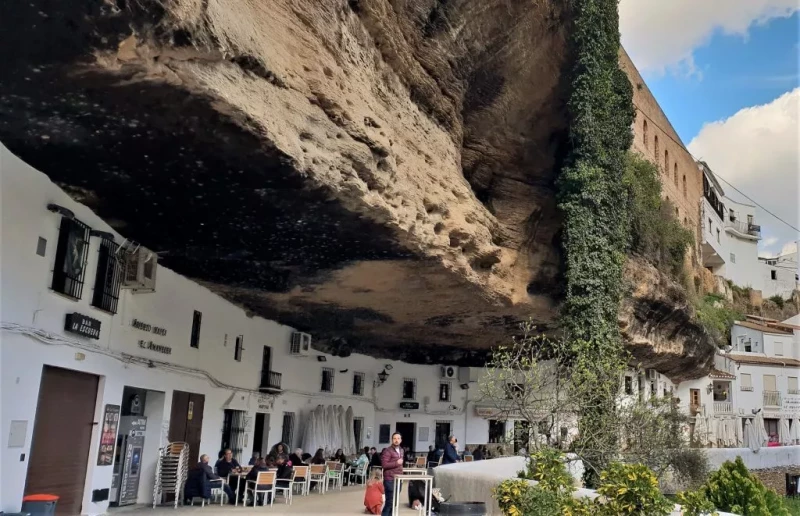
Setenil de las Bodegas is a unique and picturesque village located in the province of Cádiz, Andalusia, Spain. What makes Setenil distinctive is its remarkable setting: many of its houses are built into the cliffs of the gorge carved by the Guadalporcún River. Here are some highlights to explore in Setenil:
-
Cliffside Houses: Take a stroll through the narrow streets of Setenil and marvel at the houses built directly into the cliffs. Some of the buildings have rock as their roofs, providing natural shade and a striking visual spectacle.
-
Castle and Church: Visit the remains of the Moorish castle that overlooks the village, offering panoramic views of the surrounding countryside. Nearby, you'll find the Church of San Sebastián, a beautiful example of Andalusian architecture.
-
Cueva del Sol and Cueva de la Sombra: These natural caves, meaning "Cave of the Sun" and "Cave of the Shadow" respectively, are two of the most iconic spots in Setenil. Explore these caves and learn about their history and significance to the village.
-
Gastronomy: Setenil is known for its excellent cuisine, particularly its cured meats and local delicacies. Be sure to sample dishes like "pringá" (a stew made from pork), "morcilla" (blood sausage), and "queso payoyo" (local cheese).
-
Hiking and Outdoor Activities: Surrounding Setenil are beautiful natural landscapes perfect for hiking, rock climbing, and other outdoor activities. The nearby Sierra de Grazalema Natural Park offers stunning vistas and opportunities for exploration.
-
Local Markets: Visit the local markets to experience the vibrant atmosphere and to purchase fresh produce, artisanal crafts, and other goods made by locals.
-
Festivals and Events: If you're lucky enough to visit during one of Setenil's festivals, such as the Feria de Agosto in August or Semana Santa (Holy Week), you'll have the chance to experience traditional music, dance, and cultural celebrations.
Setenil de las Bodegas is a charming village with a rich history, breathtaking scenery, and delicious cuisine, making it a must-visit destination in Andalusia. Whether you're exploring its unique architecture, enjoying outdoor activities, or indulging in local gastronomy, Setenil offers a memorable experience for visitors.
 Our tips for getting the most out of your experience.
Our tips for getting the most out of your experience.
Visiting Setenil de las Bodegas can be a fascinating experience due to its unique architecture, rich history, and stunning surroundings. Here are some tips to make the most of your visit:
-
Comfortable Footwear: Setenil's streets are uneven and hilly, so wear comfortable walking shoes to navigate the cobblestone paths comfortably.
-
Sun Protection: In the warmer months, the sun can be intense, so wear sunscreen, a hat, and sunglasses to protect yourself while exploring the town.
-
Camera: Don't forget your camera or smartphone to capture the picturesque streets built into the cliffs. The town offers plenty of photo opportunities you won't want to miss.
-
Explore the Streets: Wander through the narrow streets and alleyways to discover the unique charm of Setenil. Allow yourself to get lost in the maze of whitewashed buildings built into the cliffs.
-
Local Cuisine: Setenil is known for its delicious traditional cuisine. Don't miss the chance to try local specialties such as tapas, cured meats, and dishes featuring locally sourced ingredients.
-
Visit the Caves: Explore the caves that line the cliffs, some of which have been turned into shops, restaurants, and even homes. It's a unique experience to see how people have adapted to the natural environment over the centuries.
-
Learn About History: Visit the local museum or join a guided tour to learn about Setenil's history, including its Moorish origins and its importance during various periods of Spanish history.
-
Respectful Behavior: Remember that Setenil is a residential town, so be mindful of residents' privacy and property while exploring. Avoid making excessive noise and be respectful of local customs.
-
Parking: If you're arriving by car, parking can be limited in Setenil, especially during peak tourist seasons. Consider parking outside the town center and walking in to avoid congestion.
-
Enjoy the Scenery: Take time to soak in the breathtaking views of the surrounding countryside and the dramatic cliffs that define Setenil's landscape.
By following these tips, you can have a memorable and enjoyable visit to Setenil de las Bodegas, immersing yourself in its unique atmosphere and stunning surroundings.
15 - Baeza and Úbeda
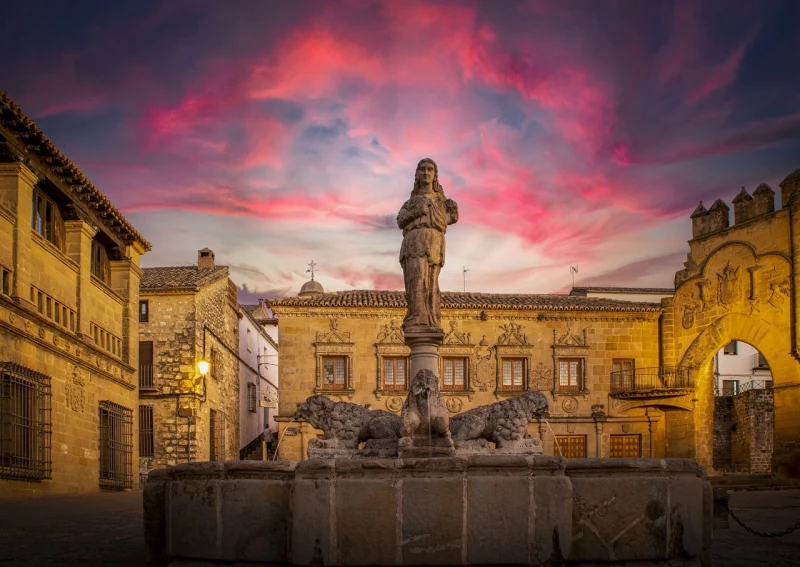
Baeza and Úbeda are two cities located in the province of Jaén, in the region of Andalusia, Spain. They are famous for their remarkably well-preserved Renaissance architecture and have been designated UNESCO World Heritage Sites due to their historical and artistic significance. Here are some highlights to visit in each of these cities:
In Baeza:
- Baeza Cathedral: Built in the 16th century, it is an impressive example of Spanish Renaissance architecture.
- Plaza de Santa María: A picturesque square surrounded by historic buildings, perfect for strolling and taking photos.
- Fuente de Santa María: An ornate fountain located on the square of the same name, offering a beautiful example of Renaissance art.
In Úbeda:
- Plaza Vázquez de Molina: A spacious and elegant square surrounded by Renaissance buildings, including the Town Hall and the Vázquez de Molina Palace.
- Jabalquinto Palace: Another magnificent example of Renaissance architecture, with its stunning facades and inner courtyards.
- Church of Santa María de los Reales Alcázares: An impressive church with a beautiful façade and richly decorated interior.
In addition to these points of interest, wandering through the narrow, winding streets of these two cities will allow you to discover many other architectural treasures and soak in the charming, historic atmosphere of the region. Be sure to also sample delicious Andalusian cuisine and immerse yourself in the local culture during your visit to Baeza and Úbeda.
16 - Cabo de Gata-Níjar
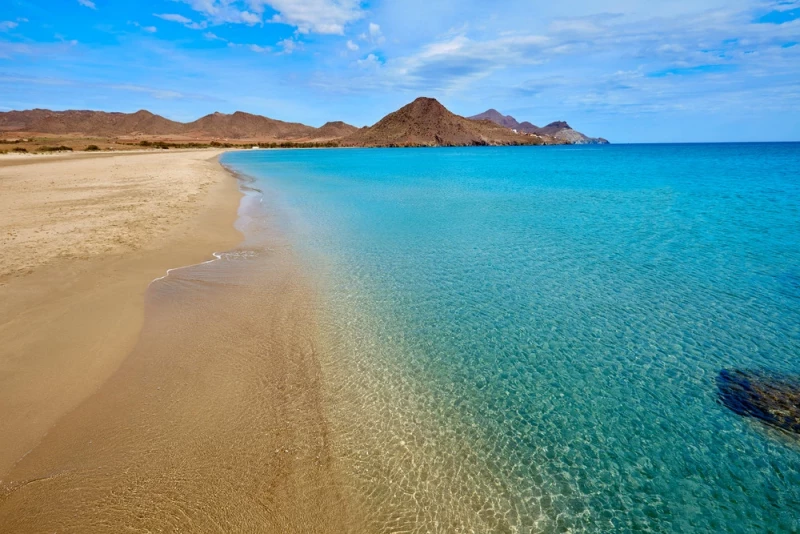
Cabo de Gata-Níjar is a natural park located in the province of Almería, in the southeastern corner of Spain, specifically in the region of Andalusia. It is known for its stunning coastal landscapes, rugged cliffs, pristine beaches, and unique biodiversity. Here are some highlights of Cabo de Gata-Níjar:
-
Coastline: The park boasts a dramatic coastline with towering cliffs, hidden coves, and crystal-clear waters. Some of the most famous beaches include Playa de los Muertos, Playa de Mónsul, and Playa de los Genoveses.
-
Volcanic Geology: The area is characterized by its volcanic origin, resulting in a diverse landscape featuring volcanic cones, lava flows, and unique rock formations. The volcanic activity has contributed to the creation of intriguing geological features throughout the park.
-
Flora and Fauna: Cabo de Gata-Níjar is home to a wide variety of plant and animal species, some of which are endemic to the region. The park's diverse habitats, including coastal dunes, salt marshes, and semi-arid landscapes, support a rich biodiversity, including rare and endangered species.
-
Salinas de Cabo de Gata: These salt flats are an important ecosystem within the park and provide habitat for various bird species, including flamingos, herons, and migratory birds. Visitors can observe birdlife while exploring the salt pans.
-
Activities: The park offers numerous outdoor activities such as hiking, birdwatching, snorkeling, diving, and kayaking. There are also designated trails and viewpoints for enjoying the stunning scenery and wildlife.
-
Villages: Within the park boundaries, there are charming villages worth visiting, such as San José, Las Negras, and Rodalquilar. These villages offer a glimpse into the traditional Andalusian way of life and provide amenities for visitors.
Overall, Cabo de Gata-Níjar Natural Park is a haven for nature lovers, outdoor enthusiasts, and anyone seeking tranquility amidst breathtaking scenery. Its unique landscapes and biodiversity make it a must-visit destination in southern Spain.
 Our tips for getting the most out of your experience.
Our tips for getting the most out of your experience.
If you're planning to visit Cabo de Gata-Níjar, here are some tips to make your experience more enjoyable and rewarding:
-
Plan Ahead: Do some research on the main attractions, hiking trails, beaches, and activities available in the natural park to maximize your time there.
-
Transportation: It's recommended to have your own means of transportation to explore the park, as public transportation can be limited, especially for accessing more remote areas.
-
Equipment: Bring appropriate gear to fully enjoy the activities offered, such as hiking shoes, snorkeling gear, binoculars for birdwatching, etc.
-
Sun Protection and Hydration: The climate in the region can be hot and dry, especially in summer. Make sure to bring plenty of water and wear sunscreen, a hat, and lightweight clothing to protect yourself from the sun.
-
Respect Nature: Cabo de Gata-Níjar is a preserved natural park, so please respect the rules and guidelines to minimize your impact on the environment. Leave no trace and stay on designated trails to avoid damaging the fragile vegetation.
-
Explore the Villages: Don't limit yourself to the coastal areas of the park. Take the time to explore the charming fishing villages and small towns inland, where you can discover local culture, cuisine, and traditional crafts.
-
Check Regulations: Some activities, such as scuba diving, may require special permits. Make sure to inquire about applicable rules and regulations before engaging in specific activities.
By following these tips, you'll be well-prepared to fully enjoy your visit to Cabo de Gata-Níjar, experiencing its spectacular landscapes, unique flora and fauna, as well as its rich local culture.
17 - Itálica
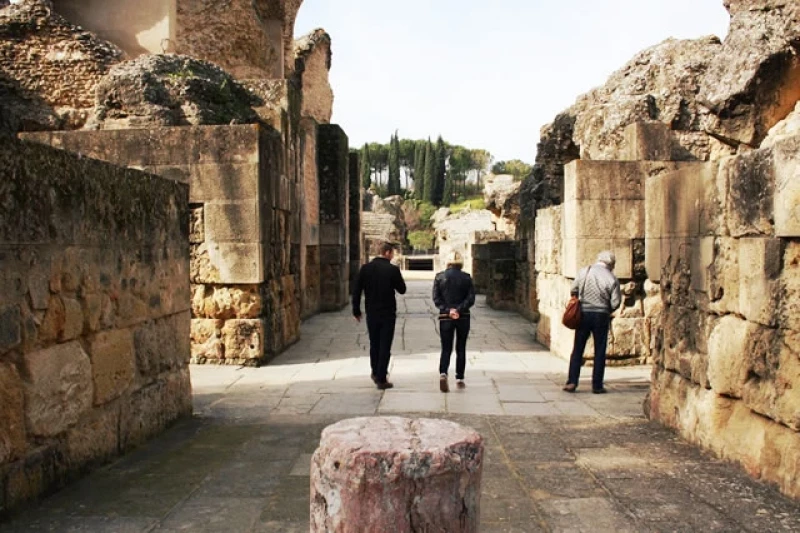
Itálica is an ancient Roman city located in modern-day Spain, just outside the city of Seville. It was founded in 206 BC by the Roman general Publius Cornelius Scipio Africanus during the Second Punic War. Itálica is particularly renowned for being the birthplace of two Roman emperors, Trajan and Hadrian.
The city reached its peak during the 2nd and 3rd centuries AD, boasting a population of around 10,000 inhabitants. Itálica was known for its impressive architecture, including well-preserved examples of Roman amphitheaters and mosaics. The amphitheater of Itálica, one of its most famous landmarks, is among the largest in the Roman Empire, with a capacity of around 25,000 spectators.
Over time, Itálica went into decline, particularly after suffering damage during invasions and conflicts in the 3rd and 4th centuries AD. By the Middle Ages, the city was largely abandoned, and its ruins were gradually covered by sediment and vegetation.
Today, Itálica is an important archaeological site and a popular tourist destination, offering visitors a glimpse into the grandeur of ancient Roman civilization in Spain. The ruins of Itálica provide valuable insights into urban planning, architecture, and daily life in the Roman Empire.
18 - Costa del Sol
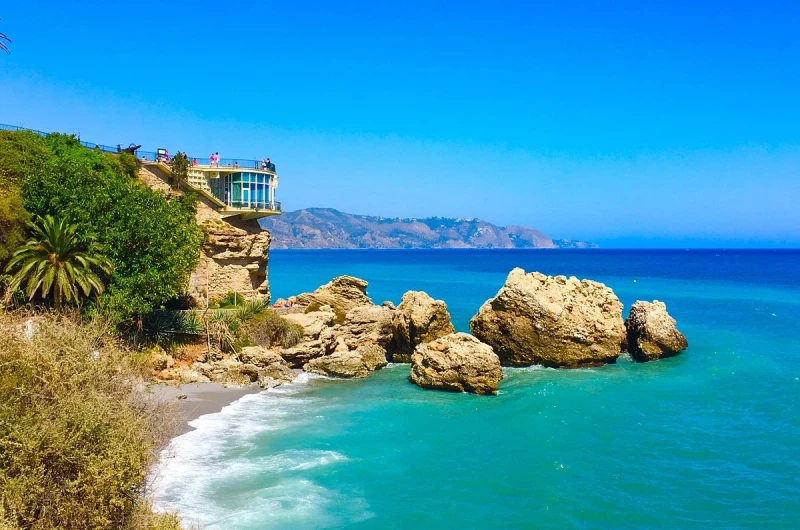
Costa del Sol, meaning "Coast of the Sun" in Spanish, refers to a region in the southern part of Spain, specifically along the coastline of the Province of Málaga in the autonomous community of Andalusia. Renowned for its beautiful Mediterranean climate, stunning beaches, vibrant nightlife, and picturesque landscapes, the Costa del Sol has been a popular tourist destination for decades, attracting millions of visitors from around the world each year.
Some of the most well-known cities and towns along the Costa del Sol include Marbella, Torremolinos, Fuengirola, Benalmádena, and Estepona. Each of these destinations offers its own unique charm and attractions, ranging from luxurious resorts and golf courses to quaint fishing villages and historic landmarks.
Marbella, in particular, is famous for its upscale lifestyle, glamorous marina, and exclusive boutiques, while Torremolinos and Fuengirola are known for their bustling beaches and vibrant nightlife. Benalmádena boasts attractions such as the Tivoli World amusement park and the Benalmádena Cable Car, providing stunning views of the coast.
Aside from its beaches and entertainment options, the Costa del Sol also offers a rich cultural experience, with historic sites like the Alcazaba of Málaga, a Moorish fortress, and the Picasso Museum in Málaga, birthplace of the renowned artist Pablo Picasso.
The region's culinary scene is another highlight, featuring a diverse array of delicious seafood dishes, tapas, and traditional Andalusian cuisine, accompanied by local wines and refreshing sangria.
Overall, the Costa del Sol is a destination that caters to a wide range of interests, from sun-seeking beachgoers and party enthusiasts to history buffs and food lovers, making it a popular choice for travelers seeking a memorable Mediterranean getaway.
Andalusia - Where to Stay?
In Andalusia, there are numerous options for accommodation catering to various preferences and budgets. Here are some popular choices:
-
Hotels: Andalusia boasts a wide range of hotels, from budget options to luxurious resorts. Cities like Seville, Granada, Malaga, and Cordoba have a plethora of hotels catering to different tastes and budgets. You can find international hotel chains as well as boutique hotels with unique charm.
-
Rural Accommodations: In the countryside and smaller towns of Andalusia, you'll find charming rural accommodations such as country houses (cortijos), guesthouses, and bed and breakfasts (casas rurales). These provide a more authentic experience and often offer stunning views of the surrounding landscapes.
-
Paradores: Spain's state-run luxury hotels, known as paradores, can be found in several locations across Andalusia. Many of these are housed in historic buildings such as castles, monasteries, and palaces, offering guests a unique and culturally rich experience.
-
Holiday Rentals: With the rise of platforms like Airbnb and Vrbo, renting an apartment, villa, or holiday home has become a popular option for visitors to Andalusia. This can be a great choice for families or groups looking for more space and flexibility during their stay.
-
Hostels: For budget-conscious travelers, hostels are available in major cities like Seville, Malaga, and Granada. These offer affordable dormitory-style accommodation as well as private rooms, often with communal facilities and a social atmosphere.
-
Camping: If you prefer outdoor accommodation, there are campsites scattered throughout Andalusia, particularly along the coast and in natural parks. Camping provides a budget-friendly option for those who enjoy outdoor activities and nature.
Regardless of your choice, it's advisable to book accommodation in advance, especially during peak tourist seasons, to ensure availability and secure the best deals. Additionally, consider factors such as location, amenities, and proximity to attractions when selecting your lodging in Andalusia.
Andalusia - How to get around?
To get around and visit Andalusia, there are several options:
-
Car rental: This is the most flexible option for exploring the region as it allows you to travel at your own pace and access more remote or less accessible places compared to public transportation. Highways in Andalusia are generally well-maintained, and there are numerous car rental services available in major cities and at airports.
-
Train transport: Andalusia has a good railway network connecting major cities such as Seville, Malaga, Cordoba, and Granada. High-speed trains (AVE) are fast and comfortable, providing a convenient way to travel between the major cities in the region.
-
Bus: Buses are an economical means of traveling in Andalusia, with frequent connections between different cities and villages. Several bus companies operate in the region, including Alsa and Socibus. Buses also offer a convenient way to visit attractions located outside urban centers.
-
Bike rental: In cities like Seville and Malaga, bike rental is a popular option for getting around and exploring local attractions. Many cities also have well-developed bike paths, making it a pleasant and eco-friendly way to travel.
-
Walking: For exploring the historic quarters of Andalusian cities or enjoying natural landscapes, walking is often the best way to get around. Many tourist attractions are easily accessible on foot, and it also allows you to better appreciate the local atmosphere and discover off-the-beaten-path places.
Depending on your travel preferences, budget, and itinerary, you can choose the combination of transportation modes that best suits you for exploring Andalusia.
Andalusia - Best period
The best time to visit Andalusia depends on your preferences and what you want to experience during your trip. Here's a breakdown of the seasons:
-
Spring (March to May): Spring is a fantastic time to visit Andalusia. The weather is mild and pleasant, with blooming flowers adding charm to the landscape. This season is ideal for exploring cities like Seville, Cordoba, and Granada, as well as the region's natural beauty.
-
Summer (June to August): Summer in Andalusia can be very hot, especially in inland areas like Seville and Cordoba, where temperatures can soar above 40°C (104°F). However, if you're looking to enjoy the region's beaches along the Costa del Sol or Costa de la Luz, summer is the perfect time. Just be prepared for crowds and book accommodations and activities in advance.
-
Autumn (September to November): Autumn is another excellent time to visit Andalusia, especially in September and October when temperatures start to cool down from the summer heat. The weather remains pleasant, making it ideal for sightseeing, outdoor activities, and exploring the region's rich cultural heritage.
-
Winter (December to February): Winter in Andalusia is mild compared to many other parts of Europe, but it can still be quite chilly, especially in the mornings and evenings. This season is perfect for exploring indoor attractions like museums, palaces, and historic sites, as well as enjoying outdoor activities in the mountains, such as skiing in the Sierra Nevada.
Overall, the shoulder seasons of spring and autumn are considered the best times to visit Andalusia, offering pleasant weather, fewer crowds, and a perfect balance for exploring both the cities and the natural beauty of the region.
